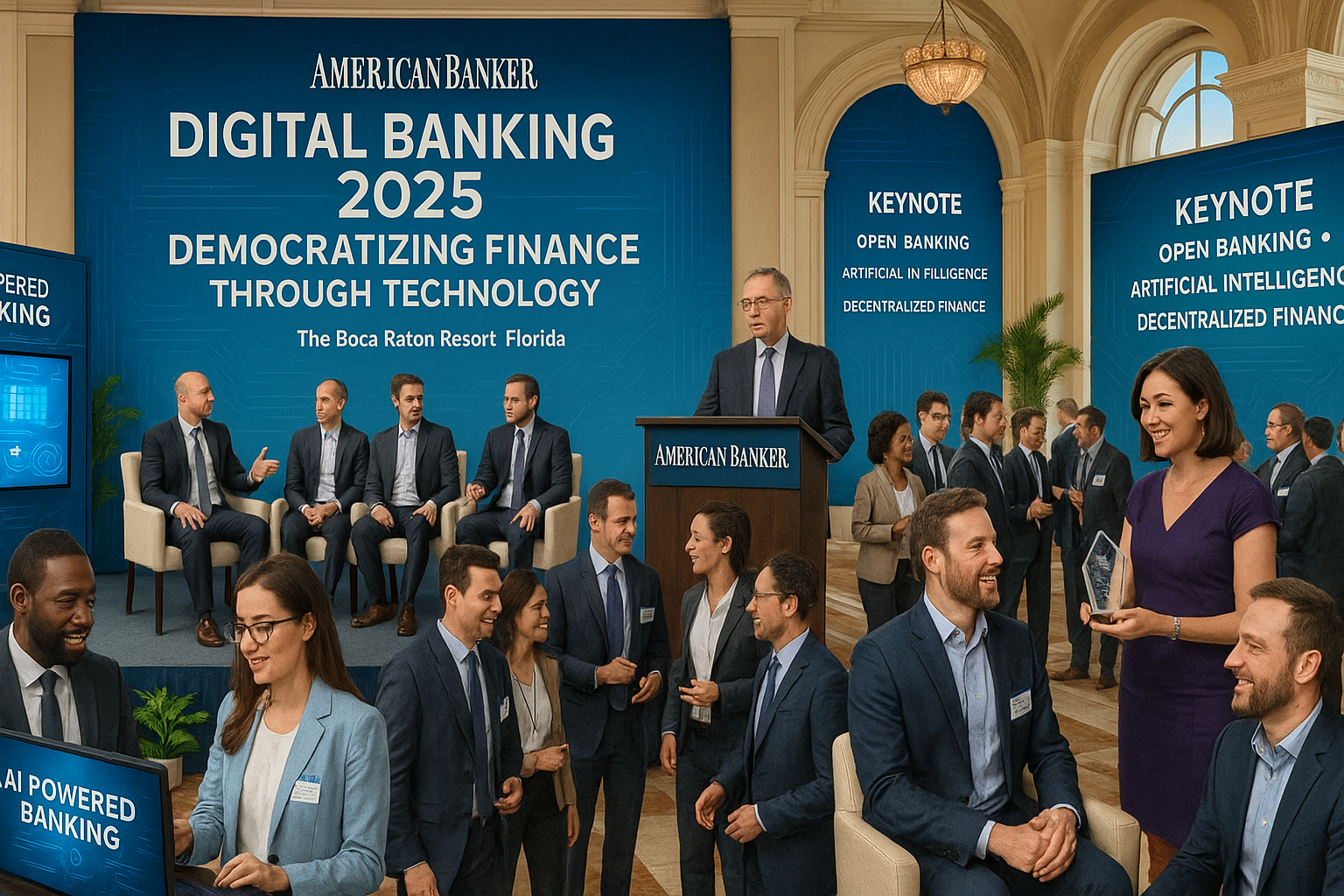Unveiling the Future: Key Insights from the American Banker Digital Banking Conference 2025 on Technology-Driven Financial Transformation
The recent American Banker’s Digital Banking Conference at The Boca Raton Resort in Florida showcased a transformative vision for the financial services industry, highlighting how emerging technologies are reshaping the banking landscape.
Digital Banking 2025: Democratizing Finance Through Technology
The overarching theme of American Banker’s Digital Banking Conference this week centered on how open banking, artificial intelligence, decentralized finance, and Web3 technologies are rapidly accelerating the democratization of financial services. These innovations are creating digital access to cheaper, faster, and highly personalized products that meet evolving customer demands.
The four-day event brought together leaders from across the financial spectrum—from traditional banks to cutting-edge fintechs—for keynotes, panels, demos, and networking sessions focused on the future of banking. With over 100 expert speakers sharing forward-thinking insights, attendees gained valuable perspectives on navigating the changing financial landscape.
In a provocative keynote, BitGo CEO Mike Belshe declared that “stablecoins are the banks that people wish they had but never had,” highlighting how digital assets are challenging traditional banking models and customer expectations.
Innovation Takes Center Stage
The conference debuted American Banker’s Innovation of the Year award, recognizing groundbreaking financial technologies launched in 2024. The overall winner, announced Monday, was JPMorgan Chase’s LLM Suite, which democratizes generative AI technology across the firm’s workforce.
Another honoree, Citizens Financial, was recognized in the Open Banking and Open Finance category for incorporating commercial banking customers into its API alongside other customer types—an approach the bank is continuing despite regulatory uncertainty.
Citizens’ Head of Digital and Omnichannel Banking, Lamont Young, advised during a Tuesday panel: “If you had a strategy in place prior to this administration and the dismantling of the CFPB and you feel like your strategy is strong, I would say it should be full steam ahead.” He emphasized that protecting client data and institutional security remains paramount regardless of regulatory shifts.
Strategic Fintech Partnerships Reshaping Banking
KeyBank’s expanded partnership with payment fintech Qolo exemplifies how banks are leveraging strategic alliances to enhance their technological capabilities. Diana Welch Howell, head of alternative and fintech strategies for KeyBank’s commercial bank, explained: “For the past 10 years we’ve developed this muscle around fintech partnerships. One of the core components of that, after we’ve co-developed a product that meets clients’ needs and we’ve shared the best of both worlds culturally, is being able to deepen that relationship with an equity investment.”
This investment builds upon their existing collaboration, which already produced KeyVAM, a virtual account management platform for treasury clients launched in early 2024.
Fee-Free Banking: A Credit Union Success Story
While many financial institutions eliminated overdraft fees to avoid regulatory scrutiny, Amplify Credit Union in Austin, Texas took a different approach. Stacy Armijo, Amplify’s chief experience officer, shared how eliminating all fees—which previously generated $2 million annually—actually improved their financial performance.
The fee-free model served as a powerful differentiator, driving a 5% higher-than-expected growth in checking accounts and 8% in savings accounts during the first year. This growth improved net interest margin and increased interchange income from debit card transactions, demonstrating that mission-driven approaches can align with financial success.
The Future of Digital Assets in Banking
Anchorage CEO Nathan McCauley made a compelling case for banks to embrace cryptocurrency services during his Monday keynote. “Fifty-five million Americans own some form of digital assets, be it bitcoin, be it stablecoins, be it their favorite altcoin,” he noted. “This is a huge phenomenon. That’s about 25% of the adults within the country holding digital assets in some form. Where are they holding it? And I would guess that the answer is, ‘Not at your institution.'”
Major banks are already moving forward with stablecoin initiatives. JPMorgan Chase’s JPM Coin processes $1 billion in payments daily, while Bank of America and Citi are developing their own stablecoin offerings. However, many conference attendees indicated they’re watching for clearer regulatory guidance before fully committing to digital asset services.
AI-Powered Security: Countering Emerging Threats
As artificial intelligence creates new vectors for fraud, scams, and cybersecurity threats, financial institutions are leveraging the same technology to protect themselves and their customers.
Carl Eberling from Western Alliance Bank described their machine learning approach to robust log file monitoring, which enables interpretation of “indicators of compromise” across various channels. Thomas Mazzaferro, chief AI data and analytics officer at Truist Bank, explained how they use traditional machine learning models for defined threats while deploying generative AI solutions for detecting undefined and novel attack vectors.
Brian Minick, chief technology and information security officer at Fifth Third, emphasized that organized crime groups motivated by financial gain represent the most frequent adversaries to banks. He advocated for a “dynamic, very morphing defensive posture” that continuously adapts to evolving attacker methodologies.
Looking Ahead: Banking’s Digital Transformation Continues
The American Banker Digital Banking Conference 2025 showcased how the financial services industry is embracing technological innovation while navigating complex regulatory landscapes. With 82% of banks increasing their technology budgets according to conference data, the pace of digital transformation in banking shows no signs of slowing.
From implementing AI solutions and exploring digital assets to reimagining fee structures and forming strategic fintech partnerships, financial institutions of all sizes are finding innovative ways to meet changing consumer expectations while maintaining security and compliance.
For credit union executives, these trends highlight both opportunities and imperatives: embracing open banking philosophies regardless of regulatory requirements, evaluating fee structures through a member-centric lens, exploring strategic fintech partnerships, and deploying AI for both enhanced service delivery and improved security postures.
As demonstrated by the diverse innovations showcased at the conference, the future of banking will belong to institutions that successfully balance technological advancement with trust, security, and personalized service.


